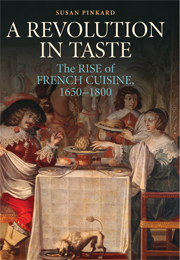Nothing is more French than sparkling champagne, you say?
 Well, not exactly. Although the wine itself comes from the province of Champagne, just to the east of Paris, the idea that a glass of champagne is supposed to be bubbly is not itself French in origin. In fact, it’s English.
Well, not exactly. Although the wine itself comes from the province of Champagne, just to the east of Paris, the idea that a glass of champagne is supposed to be bubbly is not itself French in origin. In fact, it’s English.
What? The English invented sparkling champagne? Oh, that can’t be, I hear you saying. Well, first a bit of history.
Yes, since the Middle Ages the wines of Champagne were luxury items, highly regarded for their refreshing tartness and acidity. But these champagnes were still wines, not the bubbly variety we cherish nowadays. Most of those champagnes were made of a mix of grapes in which pinot noir predominated, imparting a pale pink to light red color to the wines (the palest pinks were called “vin gris,” those of slightly deeper hue were known as “oeil de perdrix”—or “eye of the partridge”—while the darkest were a pale garnet color). Thanks to easily navigable water routes down the Marne River to the Seine and beyond the to English Channel, this still champagne was widely distributed, and it commanded handsome prices in the markets of Paris, London, and other cities of northern Europe.
However, in the second half of the 17th century, this rosy picture began to change.
Consumer preferences shifted towards fuller bodied red wines. Champagne began losing its market share to the more robust versions of pinot noir from the Côte d’Or and Beaune or to velvety, high-quality clarets from Bordeaux. Another blow fell when Louis XIV’s doctor declared that champagne was too acidic for the royal digestion and ordered the king to henceforth drink nothing but burgundy. As Mel Brooks once put it, “It’s good to be the king.” Alas, champagne, so long a symbol of courtly elegance, found itself falling out of fashion in France.
Champagne’s fortunes revived thanks to an accident of history: the invention and diffusion of the modern wine bottle. Glass carafes had been used for serving wine in antiquity, a practice that was revived in Renaissance Italy, as glass technology became established first in Venice and then in other cities. However, these early glass vessels were fragile and precious, appropriate for dinner service, but not for general household use. Modern glass bottles that were cheap and sturdy enough to be used for storage were in fact invented in England in the 1630s. The durability of the new bottles derived from a high proportion of sand in the molten glass, which was fired in a coal furnace that ran at a very high temperature, and a design that left a deep punt or indentation on the bottom, which increased stability. These early bottles were sealed with ground glass stoppers (corks only started to be used toward the end of the century). Significantly, the French were slow to adopt the new glassmaking technology and bottles did not become common in France until the 1720s, when they were still described as things “in the English fashion.”
Wine bottles were attractive to merchants and consumers for a couple of reasons. Although wine was still typically shipped from the vineyard in barrels, bottling it upon receipt at the warehouse or even after it arrived in the retail buyer’s cellar allowed it to be stored in containers that were easy to transport to the kitchen and dining room without spilling. More importantly, it turned out that sealing wine in bottles eliminated most of the spoilage that typically beset wines kept in cask for longer than six months. Deprived of contact with the air, wine stored in bottles did not turn into vinegar so easily nor did it develop some of the funky off-flavors that were all too common in wine stored in barrels. Although the bottles themselves and the labor it took to fill and seal them cost money, this was more than offset by the declining percentage of inventory that turned out to be undrinkable after a few months. So bottling made sense for any wine that one hoped to keep beyond Easter, provided that one had the means to afford the original outlay of funds. Well-to-do consumers who bought more expensive, better quality wines were quick to see the long-term economy, as were merchants who anticipated holding stocks for any length of time or transshipping them to other locations.
Although consumers began bottling wine for purely utilitarian reasons, they soon discovered to their utter surprise that the process could affect the taste, texture, and consistency of wine in interesting ways. The first major breakthrough in this area involved the transformation of champagne from a still wine into one that frothed with scintillating bubbles when the bottles were opened. Because of the northerly situation of Champagne and the chalk hillsides into which the deep, cold cellars were dug, newly pressed grape juice was routinely subject to very low temperatures in late autumn. As the temperatures dropped, the fermentation process slowed, often stopping completely before all the sugar in the grape must was consumed. When the weather warmed up in the spring, fermentation recommenced, causing the wine to froth and seethe with alarming vigor in its barrel.
The science behind this characteristic of champagne was not understood at the time, and it was widely considered to be a fault in otherwise excellent wines. Dom Pierre Pérignon (1638-1715), the famous cellar master of the Benedictine abbey of Hautvillers, one of the premier vineyards of the Marne valley, devoted his life to developing techniques for selecting and pressing grapes so as to eliminate the troublesome bubbles. Although the practices he put into place raised the quality of the abbey’s wines by several notches and in the process set a new standard for the entire region, he did not succeed in eliminating all of champagne’s natural fizz. Barrels of even the “best” champagne continued to erupt into frothing masses around the time of the spring equinox. Consumers had long since realized that patience was the only solution to this situation: in six weeks or so, the wine in barrels would settle down again for mysterious reasons (today we know that the gas generated by the secondary fermentation escaped through the seams in the barrel). By the end of April, the champagne tasted better than ever.
Bottling for storage before the secondary fermentation occurred changed the dynamics of this process by trapping the carbon dioxide and dispersing it in the liquid. If the bottles did not explode (and anywhere from ten to eighty percent of champagne bottles did before the 1830s, when a device for measuring sugar content precisely was invented), the result was wine that foamed into mousse when it was uncorked.
Historians now generally agree that the technique of making sparkling champagne was discovered by consumers rather than producers of the wine. Like the bottles that made it possible, champagne mousseaux was an English creation. Champagne of the traditional, still sort had been known and prized in England for a long time—Henry VIII employed an agent in Ay, the village where some of the choicest Marne valley wines were made, in order to insure that the royal cellars received regular shipments. Imports flagged during the Civil War and the Interregnum but revived at the time of the Restoration of the monarchy in 1660. For example, the Earl of Bedford placed an order for three tonneaux (about 750 gallons) of champagne Sillery 1664, a vin gris from the vicinity of Reims.
Sometime in 1660s, these aristocratic consumers—or their stewards or the London merchants who handled their orders—got the idea of bottling some of the wine for storage. When the some of the bottles were uncorked a few months later, the wine frothed with scintillating bubbles. The Englishmen were delighted with the festive character of the fizzy wine, and the fashion for sparkling champagne was launched. Although it would remain a costly luxury (due to the high rate of exploding bottles), supplies of sparkling champagne soon became plentiful enough in London that the middle-class but aspiring Samuel Pepys bought two bottles to drink during a carriage ride through Hyde Park with a woman who was not his wife.
Meanwhile, conservative French gourmets continued to look down on sparkling champagne as a mere novelty for another half century. However, by the 1720s, the French themselves—or at least the Parisians—awoke to the heady pleasures of drinking sparkling champagne. Voltaire declared that effervescent champagne was the only wine that a woman could drink without becoming drunken and ugly. With press like that, there is little wonder that the sparkling vintages of Reims and Epernay soon commanded four times the price of fine burgundies from Montrachet and Clos de Vougeot. But there is no doubt that the English—and not the French—were the vanguard of the champagne revolution.
With the wind howling around NYC last night and again this morning, I could really go for Pinkard’s adaptation of Marin’s herbed soup. I snagged this from her book, A Revolution in Taste. -J
POTAGE AUX HERBES (MARIN)
Makes a Little More Than 2 Quarts
This simple soup shows off fresh garden herbs and can be varied in many interesting ways, as the season and budget allow (see variations, following). Although the recipe appeared in Marin’s section on cuisine bourgoise, it resembles the potages de santé discussed by La Varenne and Bonnefons in its straightforward combination of seasonal produce and first-rate bouillon.
Equipment: A lidded pot or saucepan big enough to hold the bouillon and herbs; a wooden spoon, soup bowls, and a ladle.
VARIATIONS ON POTAGE AUX HERBES
Marin noted that many different vegetables could be combined with bouillon to make a variety of soups that were tasty, healthy, and economical. All of these variations were concocted along the same general lines as the preceding recipe. For example, he wrote that turnips could be peeled, cut into whatever shape one desired, and saut´eed in fat until they were light brown. Seasoned with a pinch of salt, the turnips were then simmered in bouillon until tender, creating potage aux navets.13 Leeks, onions, parsnips, carrots, cabbage, and cucumbers provide other possibilities and can be used alone or in combination: saut´e them, moisten with bouillon, and simmer until tender. Marin advised readers to buy whatever vegetables were cheap and fresh on a given market day – a strategy that was sure to provide variety throughout the year.
Latest Comments
Have your say!